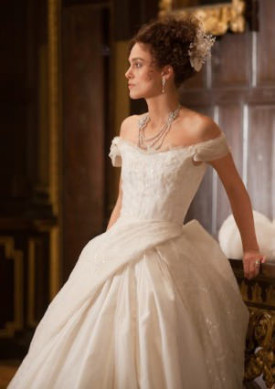
Fashion and Film
Oscar Winner: Anna Karenina’s Costume Designer, Jacqueline Durran
If you’re an Oscar affeciando, then you are well aware that Costume Designer Jacqueline Durran just won an Oscar for her work on the film Anna Karenina. Ms. Durran previously designed the costumes for Pride & Prejudice and Atonement. Earlier this week, Ms. Durran won the Costume Designers Guild Award for Excellence in Period Film for her work on Anna Karenina. Recently, I had the privilege of interviewing Ms. Durran about her work on Anna Karenina and her collaboration with the film’s director, Joe Wright. For this version of Anna Karenina, the decision was made to reinterpret the period costumes and not to faithfully reproduce them from Tolstoy’s novel . Here’s what Ms. Durran had to say about her work on the film.
Is there an overriding arc to the costumes? Are there crucial points in the film represented by the costumes?
The undergarments that she wears in the beginning and the end were very similar, but they are different colors. And the black ballgown she wears when she first meets Vronsky is mirrored in the white ball gown she wears at the end when she is humiliated at the opera. So there are reflections of the costumes, but there isn’t an overriding arc from start to finish.
Was the fur in the movie vintage and was it real?
It was all real fur unfortunately because we couldn’t find substitutes that looked in anyway as good as the fur we needed for the collars. And we tried to use vintage fur as much as possible. The costume houses have quite a lot of vintage fur that they have accumulated over the years. In the few cases we couldn’t find something, we would have to buy from a furrier.
Tell us about the jewelry used in the film?
Way back in the beginning in a discussion with Joe (Wright) & Kiera, we thought it would be good for all the jewelry that Anna wore to be real. Because she lived in this rarefied world of late 19th cent Russia where there was a lot of wealth, and it seemed to play into the kind of vanity of Anna as a character to have a wide rage of jewelry as a character. Once we decided that Anna would be wearing diamonds and pearls a lot we approached Chanel and they were more than willing to help us. We went to Paris and they gave us free reign. So from the contemporary collection, I used all of the pieces which I thought were period. So the Comedia necklace is very modern, and very feminine. And the earrings with the filigree of diamond with pearls were borrowed from Chanel and I thought they fit very well. I loved watching the jewels on screen to me, they really add something.I don’t know anything that glitters like Diamonds.
Tolstoy described Anna as fastidious in her dress and appearance. She had a dressmaker and she was described as wearing Venetian Lace & Black Velvet. Did you look at that?
No, I looked at the book, but in the end you have to go with the vision of the director and the screenwriter. Because Joe had a vision of his film not being an actual 1870’s show, but one in which he wanted to pare down all of the details. That bought the costumes down to a kind of silhouette. Give all that it didn’t make sense to follow a description of a dress in the book.
When she went to the ball, she wore a black dress as she did in the novel. For that scene we went with the book because that was a picture of Anna, but we didn’t make the dress as described. The reason we decided to go with it is because it is one of the most famous costumes in literature, but also because it works in the kind of visual structure we were building for the movie. So that fact that the crowd costumes, there were 25 shades of pastel, that really sets her (Anna) off in black. The costume design in the film was reinterpreted,we didn’t refer back to the novel for any costume details. We didn’t take a direct interpretation from Tolstoy.
Tell us about the veils that Anna wore.
In the beginning , Joe & I thought the movie was an opportunity to use veiled faces because there’s something some magical and gorgeous about veiled faces. We don’t see them much in modern life. We meet with a milliner and discussed weights an fabrics. And we had hats with veils made. We knew the one with the very light embroidery would be the one she wore on the train. I didn’t know when I was making the costumes exactly how they would be used by Joe (Wright, the director.) For example the scene with her son, when she is crying, I had no idea the scene would be played with the veil down.
Sean Barrett was the milliner from the UK that we used. When she (Anna) goes to Princess Betsy’s party wearing the feather headdress the feathers go into a diamond. Those kinds of things have long since disappeared.
Did you watch any of the other Anna films?
No, I purposefully didn’t watch any of them. I felt that with such iconic women previously playing Anna (Vivien Leigh, Greta Garbo) I might be bound to be influenced by them.
Was there anything that inspired you?
I looked at a lot of paintings. I tried to get as much visual reference as I could. We went to Russia for a few days and looked at museums in Moscow. In the end, it was true that Russian high society was very influenced by fashions from Paris. For Russian regional fashion, we tried to explore that with Levin’s character. All of the peasant costumes we made for the film. Those were authentic as they were happening outside the theater So we weren’t so concerned with reinterpreting. Everyone who worked within the theater wore a uniform. The men wore Russian grey uniforms. The women wore a generic Victorian grey dress with apron to signify their function, in the story.
***********************************
Thanks to Ms. Durran for giving us the back story on the costumes behind Anna Karenina. It’s fascinating to see all the details, research and hard work that go into creating film costumes.

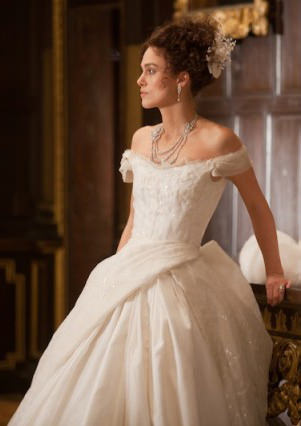
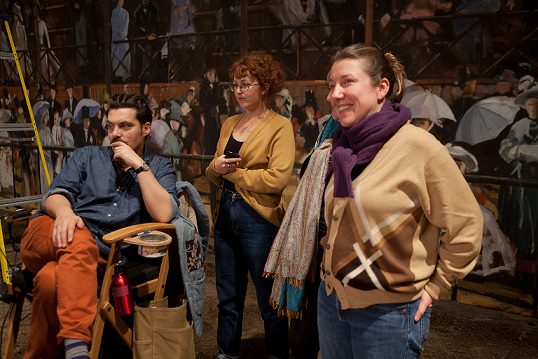




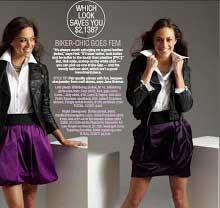
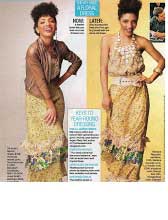






0 comments